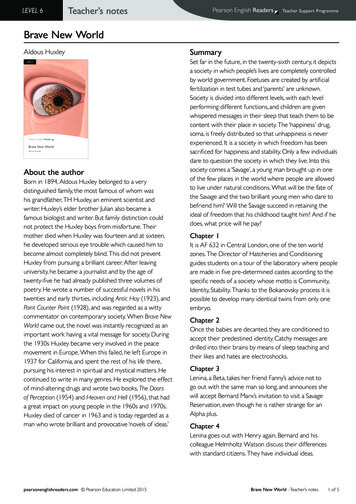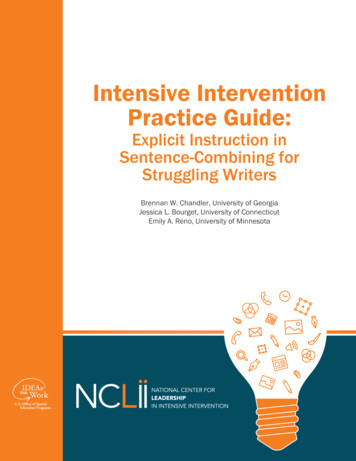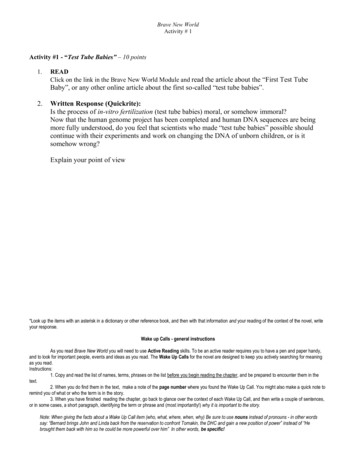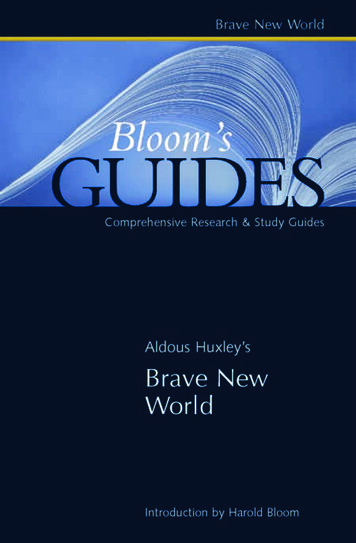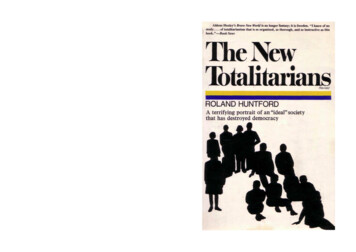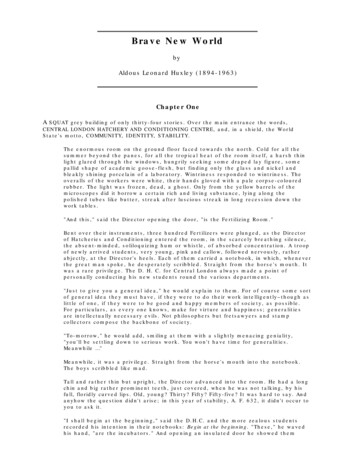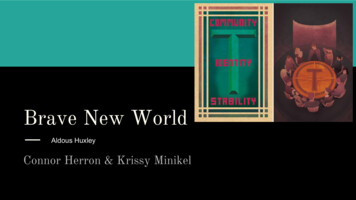
Transcription
Colloquia Document1. DETAILSCandidateStudent No.DegreeDoctor of PhilosophyStart DateSubmission DateFacultyFaculty of Arts & EducationSchoolSchool of Communication and Creative ArtsSupervisorThesis Title“Brave New World(s): Disability and the Dystopic inChildren’s Literature”Thesis TypeConventionalColloquia FormFirst year confirmationEthicsNot Applicable2. OBJECTIVE2.1 Research Questions1. How does the government of disability, and its disciplinary and biopoliticaltechniques, affect representations of Variations in dystopic texts for and aboutchildren and young adults, across different historical periods?This project maps the representational shifts in regard to the disabled, in texts forchildren and young adults that feature dystopic settings and themes, across fourhistorical periods: the late 1800s, the 1950s, the 1990s, and the contemporary periodof the early 2010s. It seeks to understand disability as a form of government in theFoucauldian sense, considering how various disciplinary and biopolitical techniquesthat inform disability are utilised to create the disabled subject (both historically andtextually). Considering that “post-disaster fiction has consistently depicted the presentas history and uses this temporal relationship as a strategy to foreground dystopian
tendencies in present societies” (Bradford, C, Mallan, K, Stephens, J & McCallum, R2008, p 13), the dystopic is a significant entry point to this discussion due to the wayin which ideology can inform texts, but also how texts can be a space for talking backto ideology. Thus, this project takes dystopic literature for and about children andyoung adults as its focus for this investigation3. RATIONALE AND SIGNIFICANCE3.1 BackgroundThe history of nonnormative physicalities and mentalities, or as I prefer, Variations,in literature and art is as long as the history of literature and art themselves, withrepresentations to be found as far back as the Bible and in numerous mythologies1.Despite this history, it is only in the last three decades that representations of thedisabled have become an interest of academic scholarship.Discussions of disability and Variations have changed significantly over the last fewcenturies. As Henri Jacques-Stiker demonstrates in his book A History of Disability(1999 ed, trans. Sayers, W), ideas and modes for thinking about disability andVariations have altered throughout history. However, these discussions have mostrapidly changed in the last twenty-five years. Tobin Siebers describes the ‘medicalmodel’ of disability, and its relationship to historical concepts, succinctly noting,“Disability has been a medical matter for as long as human beings have sought toescape the stigma of death, disease, and injury. The medical model defines disabilityas an individual defect lodged in the person, a defect that must be cured or eliminatedif the person is to achieve full capacity as a human being” (Disability Theory, 2008, p3). This model, which sought to pathologise, categorise, institutionalise and, asSiebers suggests, cure and even eliminate people with disabilities, became seen “asnatural, and individual and medical, and inexorable” (Shakespeare, T 2000, p 160).During the rights movements of the 1950s—1980s, this model of disability cameunder great scrutiny; the Union for the Physically Impaired Against Segregation1For examples see Snyder, S L & Mitchell, D T 2000, Narrative Prosthesis: Disability and theDependencies of Discourse, University of Michigan Press; Stiker, H-J 1999 (1997), (trans.) Sayers, W,A History of Disability, University of Michigan Press; Arwill-Nordbladh, E 2012, “Ability andDisability. On Bodily Variations and Bodily Possibilities in Viking Age Myth and Image”, in BackDanielsson, I-M & Thedéen, S (eds), To Tender Gender: The Pasts and Futures of Gender Research 1447/FULLTEXT01.pdf#page 35; Garland, R 2010 (1995), The Eye ofthe Beholder: Deformity and Disability in the Graeco-Roman World, Bristol Classical Press, London.
(UPIAS) and The Disability Alliance’s discussion of “Fundamental Principles ofDisability” in 1975 (accessed 03/02/14) was one of the first calls from disabilityactivism groups for a conceptual framework which understood “disability not as anindividual defect but as the product of social injustice, one that requires not the cureor elimination of the defective person but significant changes in the social and builtenvironment” (Siebers, T pp 3-4). Thus social models of disability were established,where impairment became understood as a physical noted difference, and disability associo-cultural reactions to that difference, and as a form of social oppression. Sieberscontinues, noting that,Disability studies does not treat disease or disability, hoping to cure or avoid them; itstudies the social meanings, symbols, and stigmas attached to disability identity and askshow they relate to enforced systems of exclusion and oppression, attacking thewidespread belief that having an able body and mind determines where one is a qualityhuman being (p 4).It is significant to note that there are two ‘social models’: the American social modeland the British social model. This project utilises the distinctions made by the Britishsocial model, a separation between “impairment” as noted difference and “disability”as socio-cultural reactions to that difference and as a form of social oppression, withspecific reconceptualisations.3.2 SignificanceDespite the long history of representations of Variations in art and literature, there isvery little scholarship on these representations in both children’s and young adultliterature, and in relation to dystopic and fantasy fiction. Similarly, there is, at current,no scholarship that investigates how an understanding of disability as a governmentthat operates through disciplinary and biopolitical techniques can enhance analyses ofrepresentations of Variations in literature. From this point, the foremost significanceof this project lies in its interdisciplinary scope and its contributions to variousknowledges. For disability studies, this research will apply and extend MichelFoucault’s work to garner new understandings of disability and Variations, and thecomplexity of their representations. Both in the field of literary studies and inchildren’s literature, this research addresses an absence of scholarship in relation torepresentations of Variations and discussions of disability in dystopic fiction for andabout children and young adults. Moreoever, it addresses the complex biopolitical anddisciplinary nature of disability and how representations can be and have been
affected historically. Combining critical and cultural theories, and specifically NewHistoricist approaches, this research will articulate and demonstrate new ways forunderstanding disability and Variations both contemporarily and historically, and howthese reconceptualisations can be utilised in relation to literature and art.3.3 RationaleMichel Foucault’s work investigates the complex politics that have impacted sociocultural, political, and historical understandings of the body, power, and knowledge.This project utilises Foucault’s approach as a framework for investigating disability inliterature for and about children and young adults, with a specific focus ondisciplinary and bio-power. By rewriting a history of disability as government thatoperates through disciplinary and biopolitical techniques, this project aims to achievea new theorisation of disability as not simply a social oppression, but as a complexsystem of disenfranchisement on a multitude of different levels and intensities. Thiswill be achieved through an investigation of representations of Variations across fourhistorical periods in dystopic literature for and about children and young adults.Although the social models of disability are a significant step forward in terms ofdisability rights activism, and have brought discussions of disability into severalacademic fields (as well as contributing to the creation of Disability Studies as adiscipline), it has also come under scrutiny2. I would argue that within such models,two knowledges are predominantly privileged: sociological knowledges andexperiential knowledges. Although these knowledges are indeed quite significant inreconceptualising disability and “impairment” in social structures, they are lessvaluable when analysing dystopic and fantasy representations of Variations anddisability.In addition to the shifting understandings of disability and Variations, the concept ofthe child and methods of understanding and dealing with children have undergone keychanges historically. One of the most significant technologies effecting these changeshas been literature for and about children and young adults. Maria Nikolajeva,quoting Hans-Heino Ewers, notes that, “Children's literature, Ewers argued, was fromthe very beginning related to pedagogics. Children's literature emerged on a larger2These criticisms and reconceptualisations are varied and broad, including the work of scholars such asTom Shakespeare, Tobin Siebers, and Shelley Tremain, among others.
scale because at some time in the seventeenth century society began to recognize thatchildhood was a special period in people's lives and that children had their ownspecial needs” (1995, p ix). As Ewers points toward, it is the society that “recognises”that children have “their own special needs”; in other words, it is the society that takeshold of what children “need”, especially in relation to knowledge (pedagogy).Therefore, literature for children and young adults has always been more than‘entertainment’, but a key technology in the socialisation of children, that is, thedisciplining of children.However, in the Victorian Era, where this study begins, there was a paradigmatic shiftin the way socialising techniques in literature for children and young adults operated.Whereas up until the first half of the nineteenth century moralistic, and thussocialising, tendencies in narratives such as the fairy tale collections of both theBrothers Grimm and Hans Christian Anderson were more overt, after 1850, and mostnoticeably marked by the publication of Lewis Carroll’s Alice’s Adventures inWonderland (1865), these socialising techniques became more covert. I contend thatthis shift is most noticeable in fantasy narratives, and thus an analysis that focuses onthe dystopic, as space of complex relationships between ideology and text, will beable to demonstrate this shift, and later comparable shifts, most succinctly.4. APPROACH4.1 Conceptual FrameworkIn my reading and research to date, I have found that the term “impairment” isinsufficient; it is a heavily medicalised term, a bodycentric term, an individualisingterm, and disallows multiplicities. Following other scholarly critique of the term, andmost notably that of Shelley Tremain’s “On the Government of Disability” (2001), Ihave decided to use the term ‘Variation/s.’ This follows the lead of Katrina Arndt andMaia Van Beuren, and Sharon L Snyder and David T Mitchell, and signifies anyaspect of the human condition that sits outside of the socio-culturally and medicopolitically sanctioned norm. I want to point out that this is not inclusive of race,gender, sexuality, or class, respectively, as, although they may have once beensituated as the ‘problem’ of medicine, they no longer fall under the umbrellas ofillness, impairment, disability, or anomaly.
Similarly, in my project I move back toward the social model’s definition of‘disability’ as a form of social oppression (as indicated in the UPIAS discussion, pp 343). In recent scholarship, and undoubtedly in part due to the differing perspectivesbetween the British social model and the American social model, ‘disability’ has beenunderstood and utilised as a prediscursive identity category. If, in fact, disability is, atits most extreme, a form of social oppression, or, in the less extreme, a system ofdisenfranchisement and governance, and is investigated as such, then it should not beused as a prediscursive identity category but rather as an intrinsically discursivetechnology of power which uses the mechanisms of classification, categorisation,hierarchisation, distribution, exclusion, and management, in order to govern anddiscipline individuals and populations. In this project, disability will be referred to asa government that results, ultimately, in the disenfranchisement of people withVariations. As Tremain contends,By combining the elements of bio-power, the subject, and government from thisincomplete cluster of ideas, we can identify how a Foucauldian analysis of disablingpower would differ from the juridical conception of disability commonly employed inthe social model (and a great deal of other disability theory) (p 10).In moving beyond “the “juridico-discursive” conceptions of power that muchdisability theory takes for granted” (p 9), this project rejects the totally negativeconceptualisation of disability as ‘oppression’, and the assumptions of passivity thatthis understanding comes with, and instead moves toward a discussion of the ways inwhich ‘disability’ is both regulatory and disciplinary, and productive and constitutive.4.2 Theoretical/Methodological FrameworkAs the central focus of this project is a historical mapping of the shiftingrepresentations of Variations and disability, Disability Studies scholarship is anintegral part of this investigation. David T Mitchell and Sharon L Snyder’s NarrativeProsthesis: Disability and the Dependencies of Discourse (2000) is one of the veryfew studies that discusses the role of disability, and the representations of Variations,in literature. In analysing a number of texts, both literary and philosophical, Mitchelland Snyder demonstrate how a historical mapping of disability in literature can be“Our own position on disability is quite clear, and is fully in line with the agreed principles. In ourview, it is society which disables physically impaired people. Disability is something imposed on topof our impairments, by the way we are unnecessarily isolated and excluded from full participation insociety. Disabled people are therefore an oppressed group in society”.3
achieved. Their concepts of ‘narrative prosthesis’ (pp 6-10, and the majority ofChapter 2, pp 47-61) and ‘the materiality of metaphor’ (pp 61-64) are two of the mostuseful tools for understanding these representations. In focussing on how Variationshave been utilised historically as both a ‘narrative prosthesis’, a literary prop tofurther a narrative or effect and affect a character4, and as metaphor, acting as a cipherfor social and political commentary or philosophical inquiry, a richer understandingof how Variations are effected by the techniques of disability. Although theseanalytical tools have been useful for an engagement with representations of Variationsin literature, this thesis will move beyond an understanding of Variations assuperficial and symbolic and contend that these representations demonstrate andarticulate certain knowledges, power dynamics, and ideologies concerning Variationsand disability in a given context.Angela M Smith’s groundbreaking analysis of disability and eugenics discourse inclassic American horror cinema, in Hideous Progeny: Disability, Eugenics, andClassic Horror Cinema (2012), is another foundational work for this project. In heranalysis, Smith demonstrates the pervasiveness of eugenics discourse and thecomplex ways in which classic horror cinema can be understood as, at times, beingsupportive, and at others, articulating the insidiousness and absurdity of thisdiscourse. Due to this pervasiveness, and the continued presence of eugenic thoughttoday5, this work is fundamental to any analysis of disability that touches on eugenicsdiscourse. In focussing on films such as Frankenstein (1931), Dr. Jekyll and Mr.Hyde (1931, 1941), and Dracula (1931), Hideous Progeny reveals the efficacy andrelevance in investigating multiple representations that do not necessarily correspondto realistic depictions of Variations. Thus, Smith demonstrates the significance ofanalysing nontraditional, and nonnormative, representations of Variations inliterature.The second most significant area from which this project draws its scholarship iscritical theory, and most specifically the work of Michel Foucault. Foucault’sMitchell and Snyder note “Shakespeare’s murderous, hunchbacked king, Richard III; Melville’sobsessive, on-legged captain, Ahab; and Dickens’ sentimental, hobbling urchin, Tiny Tim” (p 17) asprime examples of characters whose Variations are utilized as narrative prostheses.5For example, nationalistic discourses are inherently eugenic with their push for an ‘ideal’ citizen(consider American nationalistic discourses both during the Cold War and post-9/11), advancements inmedical technology such as prenatal screening and testing, stem cell and genetic research, evenprostheses can be understood as eugenic.4
historical and geo-political explication of the juridical apparatus in Discipline andPunish: The Birth of the Prison (1979 [1975]) serves not just as an exemplar of thespecific methodological approach this project intends to follow, but also as a work ofgreat insight into the evolution of the judicial system. Within this complex account ofthe many facets of ‘the power to punish’ there are a number of references to therelationships between historical spaces and geo-political conceptualisations ofcriminality and the historically varied understandings of disability, madness, and thevariability of humanity. These multiple references are of great significance to thisstudy: from the relationship between torture and the sovereign, the literal dismantlingof the human body as public spectacle of the sovereign’s vengeance, which articulatesthen the close bond between the spectacle, not unlike the ‘freak-show’, and thevengeance of the sovereign, and the body with Variations as ‘branded’ spectacle ofcriminality and immorality; to the methods of surveillance employed in multipleinstitutions, and thus the self-perceptions and self-regulation this breeds, and what thiscan mean for both disability as government and for the disciplined disabled subject.This discussion of the relationship between the juridical apparatus, and morespecifically criminality, surveillance, the body, and disciplinary techniques, points tothe centrality of disability to the complex mechanisms and technologies of power.In his examination of sexuality in The History of Sexuality, Volume 1: AnIntroduction, Foucault articulates how it can be considered as both disciplinary andbio-power:On the one hand it was tied to the disciplines of the body: the harnessing, intensification,and distribution of forces, the adjustment and economy of energies. On the other hand, itwas applied to the regulation of populations, through all the far-reaching effects of itsactivity. It fitted in both categories at once, giving rise to infinitesimal surveillance,permanent controls, extremely meticulous orderings of space, indeterminate medical orpsychological examinations, to an entire micro-power concerned with the body (pp 145146).In his lectures, collected in “Society Must Be Defended”: Lectures at the Collège deFrance, 1975-76, Foucault demonstrates the difference between disciplinary and biopower in arguing that “Unlike discipline, which is addressed to bodies, the newnondisciplinary power [bio-power] is applied not to man-as-body but to the livingman, to man-as-living-being; ultimately, if you like, to man-as-species” (p 242). Likesexuality, Variations, and all the associations of illness, anomaly, abnormality, disease,
epidemics and endemics, became the object of disciplinary knowledges, both as objectto be medicalised and object of expertise; that is, as something to be known and as aspace in which expertise itself is disciplined. Whereas sexuality can be deployed asdisciplining in that it can ensure that “individual bodies can be kept undersurveillance, trained, used, and, if need be, punished” (p 242), disability, as a complexsystem of disenfranchisement, is disciplinary in that through processes of governance,that is processes of categorisation, distribution, normalisation, and management, theindividual-as-body is surveilled, trained, used, and punished. In “On the Governmentof Disability”, Tremain notes that, “Discipline is the name that Foucault gives to formsof government that are designed to produce a “docile” body, that is, one that can besubjected, used, transformed, and improved. Disciplinary practices enabled subjects toact in order to constrain them” (p 622). Thus, several domains can be considereddisciplinary, among them the prison, the hospital, the asylum, the clinic, the workshop,and the school: all of which, in some way or another, discipline bodies withVariations. In these spaces the body with Variations is subjected and produced,transformed and rehabilitated, normalised and objectivised (and thus made‘knowable’), surveilled and regulated, individualised and classified: that is, the bodywith Variations is made docile and disabled. Therefore, it is disability, as it exercisesthese disciplinary techniques, which transforms the body with Variations into thedisabled body. I contend that it is both through the intervention of disability thatbodies with Variations are disciplined. However, this is not the only way in whichdisability operates.As well as discussing the disciplinary role of sexuality in The History of Sexuality,Volume 1: An Introduction (trans. Hurley, R 1990 [1978]), Foucault also engages withthe changing utilisation of sexuality and its operation as a mechanism of biopower,which he describes thus, “an explosion of numerous and diverse techniques forachieving the subjugation of bodies and the control of populations” (p 140). Theconcept of biopower is furthered in his lectures from the Collège de France. Thecollection “Society Must Be Defended”: Lectures at the Collège de France, 1975-76(eds Bertani, M & Fontana, A; general eds Ewald, F & Fontana, A; trans. Macey, D[2003], 2004 [1997]), discusses several of his concepts, however “Chapter 11: 17March 1976” centres on the emergence and explication of biopower. He states thatbiopower is “addressed to a multiplicity of men, not to the extent that they are nothingmore than their individual bodies, but to the extent that they form, on the contrary, a
global mass that is affected by overall processes characteristic of birth, death,production, illness, and so on” (pp 242-243). Due to biopower’s concern with “theliving man, to man-as-living-being; ultimately to man-as-species” (p 242), it isapparent that Variations are of significant interest to it, especially considering itsrelationship to processes such as “the birth rate, the mortality rate, longevity”, “the rateof reproduction, the fertility of a population”, and “a whole series of related economicand political problems” (p 243). Through the interventions of the medical, the clinical,the psychological, the economic, and the political, into the lives of people withVariations, on the level of both the individualising and ‘massifying’ (Foucault, p 243),and considering disability is socio-cultural, political, and historically variablephenomena, there must be a complex relationship between disability and bio-power;and this relationship is one of governance. This reconceptualisation of disability asgovernment is one of the directions Disability Studies is now heading.In “On the Government of Disability” (2001), Shelley Tremain demonstrates how“impairment is an historical artifact of the regime of “bio-power”” (p 618) through aparalleling of discussions on the construction of the two (“natural”) sexes to that of‘impairment’. Tremain concludes this investigation by stating,In short, impairment has been disability all along. Disciplinary practices into which thesubject is inducted and divided from others produce the illusion that they have aprediscursive, or natural, antecedent (impairment), one that in turn provides thejustification for the multiplication and expansion of the regulatory effects of thesepractices. The testimonials, acts, and enactments of the disabled subject are performativeinsofar as the allegedly “natural” impairment that they are purported to disclose, ormanifest, has no existence prior to or apart from those very constitutive performances.That the discursive object called impairment is claimed to be the embodiment of naturaldeficit or lack, furthermore, obscures the fact that the constitutive power relations thatdefine and circumscribe “impairment” have already put in place broad outlines of theforms in which that discursive object will be materialized (p 632).This reconceptualisation of impairment as disability, and as created throughdisciplinary and biopolitical mechanisms, illustrates the complexity of representationsof Variations and disability and the need to investigate these representations withrespect to Foucauldian concepts. Through this analysis, Tremain demonstrates theviability and pertinence of using the work of Foucault, and especially the concepts ofdisciplinary and bio-power, to reconceptualising, rehistoricising, and analysingdisability and Variations. This project will further this analysis and Tremain’s
contention through an investigation of how disability can be understood as agovernment, and the disciplinary and biopolitical techniques it employs and, as such,how disability as a government changes historically, through an analysis of itsoperations as expressed in dystopic literature for and about children and young adults.Conversely, in the collection Foucault and the Government of Disability (2005), BillHughes’ vehemently argues against using the work of Foucault to discuss disabilitycontemporarily. Hughes contends that in Foucault’s conception of power “the activeor creative subject is invisible; that is, the subject is the product of expertclassification and regulatory techniques” (p 87), and that “[f]or Foucault, the bodydoes not act in and on the world; rather, the body is docile” (p 86). Although, to adegree, this is accurate, Hughes considers disciplinary power (the power he implicitlyrefers most to) as a kind of puppeteer, constantly pulling the strings of the body. Inmany respects, disciplinary power does take hold of the body, however Hughesassumes that this then means there is no space for agency and posits disabilityactivism movements as evidence to the contrary, noting that, “[i]f power is reduced tostructures of domination, it is not logical for impaired people to contest disabilism.Only fatalism makes sense” (p 90). On the contrary, Foucault demonstrates thatpower and domination are not equitable, but rather domination can be an effect ofpower: “but in making detention the penalty par excellence, it introduced proceduresof domination characteristic of a particular type of power” (1979 [1975], p 231). Moreto the point, I contend that although Foucault’s discussions of disciplinary power donot focus on issues of agency, to assume that his concepts of disciplinary powerpreclude any form of agency is nonsensical. If agency does not exist underdisciplinary power, the question of the use of any of the apparatuses Foucaultdiscusses needs to be asked. However, if on the contrary, Foucault’s concepts assumeagency, then these disciplinary apparatuses have purpose. Tremain replies to thisarguing,Hughes and [Kevin] Paterson allow that the approach to disability that I recommendwould be a worthwhile way to map the constitution of impairment and examine howregimes of truth about disabled bodies have been central to governance of them. Theseauthors claim nevertheless that the approach ultimately entails the “theoreticalelimination of the material, sensate, palpable body”. This argument begs the question,however; for the materiality of the “(impaired) body” is precisely that which ought to becontested. In the words of Judith Butler, “there is no reference to a pure body which is
not at the same time a further formation of that body”. [T]he historical approach todisability that I recommend does not deny the materiality of the body; rather, theapproach assumes that the materiality of “the body” cannot be dissociated from thehistorically contingent practices that bring it into being, that is, bring it into being as thatsort of thing. Indeed, it seems politically naïve to suggest that the term “impairment” isvalue-neutral, that is, “merely descriptive”, as if there could be a description that was notalso a prescription for the formulation of the object (person, practice, or thing) to whichit is claimed to innocently refer. Truth-discourses that purport to describe phenomenacontribute to the construction of their objects (p 621).This response highlights the significant shift between current conceptualisations ofdisability and “impairment” and the social models of disability, as well as thesignificance of utilising Foucauldian thought to interrogate these concepts. AlthoughHughes, makes some interesting points, he seems to contend, in alignment with socialmodels approach, that disability and ‘impairment’ are distinct, discrete categories; andthus, that the ‘material, sensate, palpable body’ is separable from the government ofdisability which invests and regulates them. With the dissolution of this separationthat Tremain achieves, and her interrogation of the concept of ‘impairment’(especially as it pertains to the body), leaves Hughes and Paterson’s argumentweakened. Although, of course, the body needs to be recognised and included indiscussions of disability, their presumption of the prediscursive nature of‘impairment’, or their reliance on the body as the central figure to these discussions,further problema
centuries. As Henri Jacques-Stiker demonstrates in his book A History of Disability (1999 ed, trans. Sayers, W), ideas and modes for thinking about disability and Variations have altered throughout history. However, these discussions have most rapidly changed in the last twenty-five years. Tobin Siebers describes the 'medical

